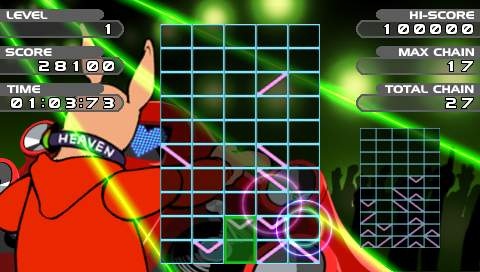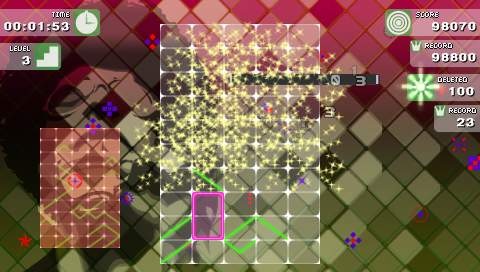Remember the WonderSwan? In case you've forgotten, it was a Japanese handheld created by the late Gunpei Yokoi, the designer of the original Game Boy. Gunpey was originally released on that system, and as a result, the game is virtually unknown by American audiences. Well it was anyway: Gunpey has made its way onto both the PSP and the Nintendo DS, and we're all the better for it. On the PSP, it's a hypnotic game that owes a lot to the handheld's flagship puzzler, Lumines. Yet while the pulsating colors and entrancing music may strike a familiar chord, the gameplay is completely different and, in many ways, even more challenging.

Gunpey's premise is simple: Lines pointing in various directions pop onto the gameplay grid from the bottom, and you must connect them from left to right. Once you've linked one side to the other, the chain is locked, and you have a few seconds to add more lines before it is removed. You use the D pad to move a two-block cursor onto the lines and a face button to move the line from one block to the other. If a line is in the top row when the next row is due to appear at the bottom, the game is over. It sounds easy, but the underlying complexity soon becomes apparent.
The first challenge you have to overcome is to only move lines vertically, so it doesn't take long for a single column to collect multiple stray lines that you can't do anything with yet. Because new lines constantly push what's already there toward the top of the grid, you're wrestling not only with connecting them, but also with moving the ones near the top further toward the bottom. Making a complete connection doesn't just cause the chain to disappear, though: It also buys you time. Once the connection is created, the lines within it are immovable for a short period. Not only can you add other lines to the chain, but you can also move them through it, and no additional lines will pop up while your chain is actively frozen. This downtime presents an opportunity for you to get your stray lines in order.
At first, a grid full of lines might look a little minimalist if you're used to the more visually appealing blocks and marbles that are common to the genre. But it's a nice change that grows on you once the levels start moving along. If you've already arranged your lines and are still waiting for the next row to appear, all you have to do is tap the X button to pull them up. The first minute of play moves along slowly, but the closer the lines get to the top, the more quickly new rows appear. The resulting button mashing is hectic and satisfying, as well as a little tricky.
While the gameplay is strong, it's the Lumines-inspired production design that raises Gunpey to an entirely different level. Like Lumines, Gunpey features various colorful and glowing skins that lend each new level a completely different feel. Yet while the inspiration is a little too obvious, Gunpey's style is entirely unique and more than a little odd. Skins have titles like "The Afroman in Friday's Café," and their themes are just as weird as they sound. "Lazy Kangaroo" presents a DJ kangaroo named Heaven (or at least, that's what his collar says), spinning tunes in a dance club, while other skins feature Japanese gardens and defecating dogs. And those are some of the more conventional skins. Meanwhile, the club tunes are almost as hypnotic as those in Lumines; thus, moving and connecting lines on the grid complements the music with perfectly meshed sound effects.
The only problem is that some levels feature busy skins that get in the way. For example, "Jerky Animation" is covered with blue and orange squares that flow across the screen. It's distracting and not really all that attractive. And the vibe won't be everyone's cup of tea, because not every puzzle gamer is bound to be enamored with rotating samurai heads or with dogs taking a dump.
But there's a lot here to keep you occupied. Challenge mode is the crux of the game, where you progress from one level to the next, unlocking skins for use in other modes. Double skin mode is easily our favorite, although it isn't for the faint of heart. In this mode, you deal with two concurrent game grids, each with a different skin, and you switch back and forth between them using the PSP's shoulder buttons. It gets outrageously hard but never all that frustrating because it keeps you coming back to hone your skills. If you find things too difficult, you can choose "break" rules, which cause lines above to drop a row when a chain is eliminated, but it's really only a mild concession. The 10 x 10 mode presents its own kind of challenge because the grid is twice as wide as in the other modes. You can create wildly extensive chains, but you'll be tapping buttons at an insane rate.

Because the grids get off to a relatively slow start, the time attack mode isn't as fulfilling as the other modes. There is a versus mode, but it's an ad hoc two-player-only affair, so you can't take on the artificial intelligence. It works well, though, without any noticeable connection issues or other glitches. It's also worth noting that you have to save your progress manually, which the game doesn't explicitly mention. Considering Gunpey's similarities to Lumines, this is bound to catch some players off guard. Exiting to the title screen doesn't prompt you to save, either--so be mindful.
If Gunpey doesn't quite offer the same slick marriage of play and presentation everyone loved in Lumines and its sequel, it's still quite good in its own right. Not only is it fun and challenging, but it's got a crazy sense of style and a rewarding level of difficulty. Besides, there's a kangaroo DJ. What's not to like?